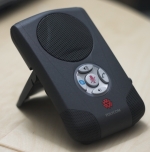First look at Polycom Communicator C100S


Earlier this month I got an announcement from Polycom about their soon to be released Communicator C100S speaker-phone product which is optimized for Skype. As a heavy user of Skype which is notoriously bad at echo and feedback suppression, I was very excited about the acoustic features of this new product and wanted to see if it really lived up to the specifications. Two weeks later, I got this review unit shown in the picture to the left and I immediately proceeded to try it out.
Once plugged in, drivers were automatically detected and installed by Windows XP SP2 and I was able to use the C100S right off the bat. The only things missing without the Polycom Communicator software were the advanced audio processing and the API integration with Skype which permits the use of the front buttons on the C100S. Even so, the unit was already sounding better than any speaker/Mic combination that I've ever used.
I first called Jason on his regular telephone and it sounded ok but that may not have been a good test since the call was relayed and re-encoded multiple times. I then called Jason using a Skype-to-Skype call and it sounded absolutely amazing and the wide-band 16 KHz audio really showed off the Communicator's quality. The results were crystal clear and loud enough that I had to adjust the volume down. Too much volume is always a good thing because you can always lower it but nothing frustrates me more than not enough volume and I have to struggle to hear. In either the Skype-to-phone or the Skype-to-Skype scenario, echo and feedback were not noticed on either end of the call. When a regular Microphone and Speaker are used with Skype, you would often hear yourself repeating your words a second later and it's frustrating. The Polycom Communicator is good enough to use in a small conference room with a few people sitting in front of it.
Here is a summary of my initial impressions of the Polycom Communicator C100S:
The good:
- Solid construction and portability
- API level integration with Skype to start and end calls
- No complicated Microphone level settings
- Can be used as an audio in/out device for other VoIP applications
- One of few products that actually has USB cable management
- Comes with earphone out jack for more private conferences
- Superb audio quality for a PC speaker phone
- Excellent echo and noise suppression for Skype
- Upgradeable software and firmware
Needing improvement:
- Could use an auto retracting USB cable
- Polycom Communicator software needs to have API integration with any VoIP soft phone and not just Skype
- A software installer that doesn't require a reboot
- Audio suppression on sounds played from other audio devices
- Skype user scrolling would be a welcome feature
The bottom line is if you're a Skype user at work, home, or on the road, this is the Skype companion to have. The list price of $129 might seem a bit high to some but considering the fact that it sounds as good or even better than conferencing phones costing several hundred dollars, it's worth the money. Typical street price discounts should bring the Polycom Communicator down to around $100 which is about $60 more than some other Skype speaker phones on the market but all the other cheaper products sound like you're speaking out of a tin can. If you really want to enjoy a hands free or headset free Skype experience, the Polycom Communicator C100S is the PC Telephony accessory of the year.